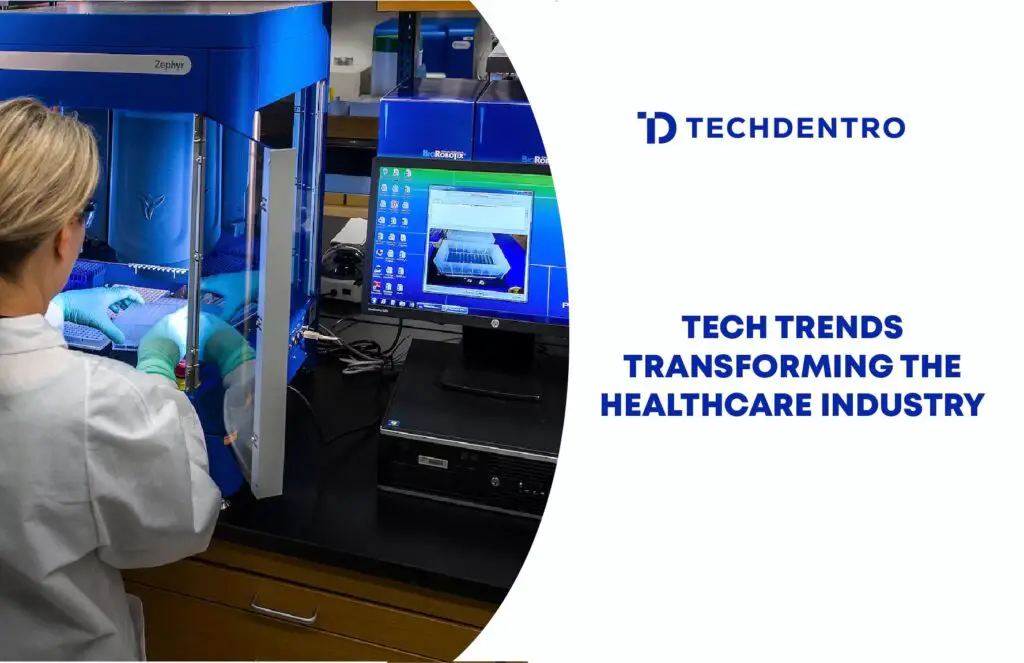Due to the merging of technology and medicine, it is expected that in 2024, we will witness significant technological advancements and breakthroughs in the healthcare sector. These advancements are anticipated to transform patient treatment, enhance patient satisfaction, and reduce costs for healthcare organizations.
When healthcare providers adopt software solutions, they should take into consideration the trends driving this transformation, as patients are seeking more optimal service, access, and efficiency. Let’s delve into these revolutionary developments that are transforming the sector in more detail.
Current Trends Revolutionizing the Healthcare Industry
The following are the latest technology trends blooming in the medical industry.
Using Cloud for Electronic Health Records (EHRs)
Storing crucial medical records on outdated on-site online servers is no longer sufficient. Cloud computing provides a modern solution for storing, managing, and utilizing EHR data. While the initial investment in cloud solutions may seem high, the long-term benefits make it worthwhile.
Augmented Reality (AR) and Virtual Reality (VR) Technologies
Virtual reality (VR) and augmented reality (AR) technology are no longer limited to video games. Recent developments in this fascinating technology have shown how their applications can expand into and benefit other industries, including healthcare.
In 2017, a group of medical professionals from around the world witnessed the successful completion of the first mixed-reality surgical procedure, following decades of development and improvement of this program. Since then, more applications, such as physiotherapy and psychiatric treatment, have become possible due to the increased accessibility of AR and VR technology.
Blockchain for Healthcare Data Security and Compliance
Block chain provides a reliable and cost-effective means of ensuring the sharing and control of private information in a society where privacy and security are major concerns. Blockchain presents a disruptive force in the healthcare industry with its potential to save up to $100 billion a year in security and digital infrastructure costs.
Blockchain can simplify processes like insurance settlements, contractual agreements, and automated settlement renewals, and enhance the patient experience. Block chain can provide the digital infrastructure and security required to meet the regulatory requirements of most public healthcare sectors, making it an excellent fit.
Virtual Healthcare Chatbots
Clinicians benefit from virtual assistants and chatbots for diagnosis, treatment, and prescription guidance. Additionally, they assist patients by providing information that enables them to make better decisions about their own care and by responding to inquiries about their treatment.
Chatbots will increasingly be used to make and schedule appointments and integrate with electronic health record systems. Moreover, by reminding patients to take their medications and offering companionship, these virtual assistants significantly contribute to patient comfort—especially for patients who live far away or are isolated.
Digital Twins
A digital twin is a virtual representation of a real-world system, item, location, instrument, or procedure. It can be used to model anything, from an entire hospital to understand how services are provided to a single instrument, like a needle, to understand how it functions under various circumstances.
Digital replicas of the human body and specific organs have been created to simulate the impact of changes in medical interventions, prescription drugs, and lifestyle decisions. By 2024, researchers plan to create a computer twin of the human brain, which may be the most intricate digital twin ever imagined.
Artificial Intelligence (AI)
AI is an effective tool within the healthcare industry, leveraging its capability for immediate, accurate, and high-volume data analysis. By assisting healthcare companies in making the best treatment decisions and streamlining administrative tasks, AI has the potential to make high-quality healthcare more accessible and affordable. AI’s pattern-matching capabilities can efficiently address the challenge of sifting through substantial amounts of patient data for analysis.
Benefits of Using the Technology Trend in Healthcare Industry
Elevating Patient Satisfaction
In the competitive healthcare landscape, patient satisfaction is paramount. Modern healthcare software programs contribute to better satisfaction by providing enhanced performance. Features like instant access to clinical information and treatment histories, along with automated scheduling and integrated communication channels, create a seamless and efficient process.
Effective Hospital and Inventory Management
Hospitals are expanding, and their procedures become more intricate every year. As healthcare devices and equipment advance to incorporate more advanced technologies and more expensive parts, the global market for medical equipment is expected to reach $603.5 billion in 2023.
Hospitals and other healthcare facilities use specialized medical software, such as medical inventory management software, designed to control operating costs, automate inventory stocking, and ensure that critical equipment is properly maintained to efficiently manage and run these costly assets.
Comprehensive Patient Monitoring through IoT
The Internet of Things (IoT) enables remote patient monitoring. Doctors can observe, consult, and diagnose patients without physical presence, thanks to software programs that harness the capabilities of IoT. This approach enhances the monitoring of patients’ health conditions, leading to more proactive and personalized healthcare.
Reducing Errors and Administrative Burdens
Healthcare employees face significant pressure, and the risk of errors is ever-present. Healthcare software is essential in mitigating this risk by automating tedious tasks and providing high accuracy. By digitizing files and eliminating paperwork, healthcare professionals can access information with a click, reducing the likelihood of errors and simplifying administrative processes.
Adopting a Paperless Future
Healthcare software programs facilitate the digitization of documents, eliminating the need for endless paperwork. Electronic documentation not only offers convenience but also enhances accessibility and reduces the risk of misplacing important information. From doctor scripts to reports and sick notes, the shift toward a paperless era benefits both patients and healthcare professionals.
Conclusion
The merger of technology and medicine is driving a significant revolution in the healthcare sector. This convergence has led to innovations focused on improving patient satisfaction, cutting costs, and enhancing patient care, giving healthcare organizations a competitive advantage.
Modern healthcare technology and software programs bring many benefits, from improved diagnostics and treatment plans to optimized resource management and streamlined scheduling. Many of these advancements are made possible, shaping a more efficient and patient-centric healthcare environment.
